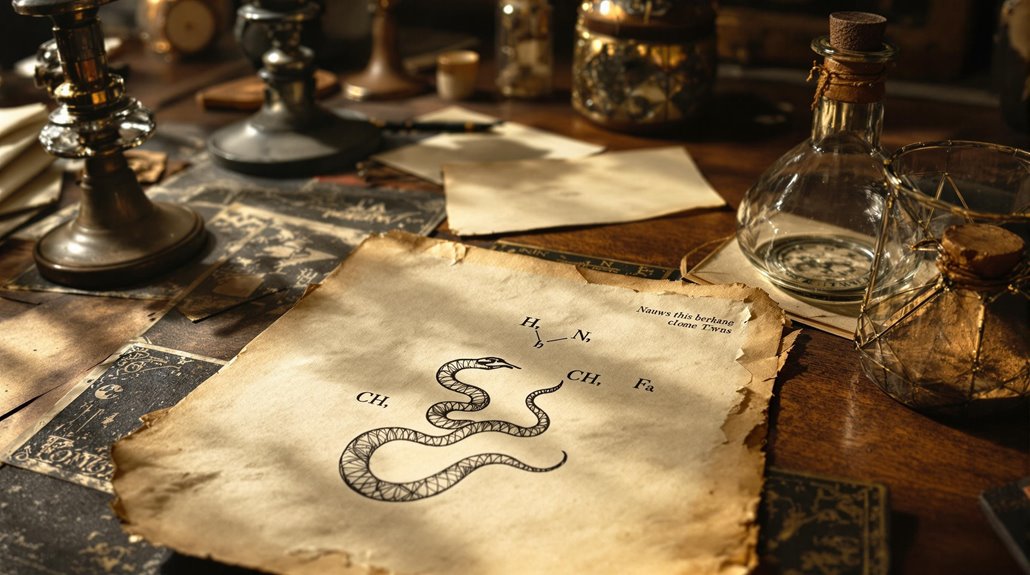He Dreamed a Snake and Solved Chemistry’s Biggest Puzzle
You've likely had one of those moments when your mind was wandering between consciousness and slumber, only to stumble upon an answer that had eluded you. That's exactly what happened to Friedrich August Kekulé in 1865, but his drowsy revelation changed the course of chemistry forever. His vision of a snake eating its tail didn't just solve the mystery of benzene's structure—it opened the door to modern organic chemistry and sparked a debate about the role of dreams in scientific discovery.
The Mystery of Benzene Before Kekulé

Before Kekulé revolutionized organic chemistry, benzene's structure remained one of science's most perplexing mysteries. You'd find chemists baffled by its empirical formula of CH, which showed an unusually low hydrogen content.
The compound's molecular stability and resistance to oxidation contradicted what you'd expect from an unsaturated hydrocarbon. The molecule fascinated early chemists because its carbon-carbon bonds were all equal in length. Early chemists found it highly effective as a universal organic solvent.
When you look at the various structural theories proposed in the mid-1800s, none could fully explain benzene's peculiar behavior. Loschmidt's ring structure and Ladenburg's prismatic model attempted to solve the puzzle, but they couldn't account for all observations.
The isomer conundrum particularly stumped scientists – you'd only find one monosubstituted variant and three disubstituted forms instead of the predicted four. These discrepancies made benzene the most enigmatic molecule of its time.
A Fateful Evening by the Fireplace
While dozing by his fireplace in Ghent during the winter of 1861-1862, Friedrich August Kekulé experienced a vision that would transform chemistry forever.
In his bachelor lodgings, he witnessed a striking image of a snake devouring its own tail, a sight that sparked his revolutionary understanding of benzene's structure.
You might wonder why this dream proved so significant. Kekulé's inspiration led him to realize that benzene's structure wasn't linear at all – it was circular.
Though he didn't share this story publicly until the 1890 Benzolfest celebration, the dream's impact was profound. His vision of cyclic structures solved a puzzle that had baffled chemists for decades, though some historians now question the dream's authenticity, pointing to similar structural proposals by Josef Loschmidt in 1861.
Before this breakthrough, Kekulé had spent time studying at the University of Giessen, initially pursuing architecture before discovering his passion for chemistry.
He later published his groundbreaking paper in 1865 proposing benzene as a six-membered ring structure.
From Ancient Symbol to Chemical Structure
The serpentine imagery in Kekulé's dream connects to a rich history of snake symbolism in science and medicine.
You'll find these serpentine symbols dating back over 2,400 years, from the Rod of Asclepius in ancient medicine to the alchemists' ouroboros representing eternal cycles.
While the caduceus with its twin snakes became mistakenly associated with medicine, it's actually Hermes' symbol of commerce. Ancient secret alchemical symbols were used to protect valuable chemical formulations from competitors. The World Health Organization recognizes the Rod of Asclepius as the correct medical symbol.
Through history, you can trace how snake imagery evolved from mystical representations to precise chemical notation.
When Dalton introduced atomic symbols in the early 1800s, followed by Berzelius's element abbreviations, chemistry began shifting toward more exact structural formulas.
Kekulé's famous benzene ring discovery, inspired by his snake dream, marks a fascinating bridge between ancient snake symbolism and modern chemical structures.
Racing Against Other Scientific Minds
During chemistry's golden age of discovery, scientists raced against each other to reveal molecular mysteries, with the pursuit of benzene's structure becoming one of the field's most heated competitions.
This scientific rivalry pushed researchers like Kekulé, Loschmidt, and Dewar to their intellectual limits as they sought to reveal benzene's secrets. Much like these early pioneers, modern researchers at Google DeepMind are racing to unlock the mysteries of protein structures. Similar competitive spirit drives modern chemists as shown by the National Retrosynthesis Competition where teams race to solve complex molecular puzzles.
The competitive collaboration among these brilliant minds produced three key outcomes:
- Multiple theories emerged simultaneously, with Loschmidt proposing his structure in 1861 and Kekulé publishing his famous hexagonal model in 1865.
- New experimental techniques developed as scientists rushed to prove their hypotheses.
- The rapid exchange of ideas sparked crucial debates that advanced organic chemistry's understanding.
You'll find that this race for discovery, though intense, ultimately accelerated scientific progress and deepened our knowledge of molecular structures.
The Legacy of a Dream-Inspired Discovery

Through one remarkable dream of a snake biting its own tail, Kekulé's benzene structure discovery has left an enduring legacy that extends far beyond chemistry.
You'll find its influence not just in scientific textbooks but in how we approach problem-solving today. Similar to how (I Can't Get No) Satisfaction emerged from Keith Richards' dream recording, revolutionary ideas can come from our subconscious minds. Just as pyramidal neurons process our waking thoughts, they continue working during dreams to unlock solutions. The dream symbolism has inspired artists and writers while highlighting the powerful role of scientific intuition in breakthrough discoveries.
You can see Kekulé's impact in modern chemistry education, where his story motivates students to think creatively and trust their subconscious minds.
His discovery revolutionized our understanding of molecular structures and laid the groundwork for aromatic compound research.
More importantly, it's changed how we view the scientific process, showing that groundbreaking discoveries don't always come from conventional thinking – sometimes they emerge from a good night's sleep.
Modern Day Impact and Health Considerations
Much like Kekulé's dream-inspired benzene discovery, modern snake research has sparked revolutionary medical breakthroughs.
Recent studies of ancient snake behavior in North America have deepened our understanding of snake evolution and adaptations.
The remarkable diversity of 4,000 snake species today provides scientists with an extensive range of compounds to study. You'll find snake venom at the forefront of medical applications, transforming how we treat life-threatening conditions. Scientists have harnessed these powerful compounds to develop medications that can save lives.











